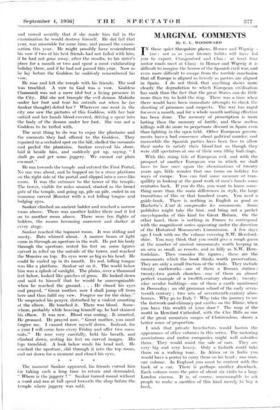MARGINAL COMMENTS
By E. L. WOODWARD
I. . N those quiet. Shropshire places, Homer and Wigwig — (no: not as as your literary habits will have led you to expect, ('hingunford and Clun ; at least four motor roads meet at Clun)—in Homer and Wigwig it is difficult to imagine the horror of the Spanish civil war, and even more difficult to escape from the terrible conclusion that all Europe is aligned as fiercely as parties are aligned in Spain. I do not think that anything shows more dearly the degradation to which European civilisation has sunk than the fact that the great States can do little more than try to hold the ring. There was a time when there would have been immediate attempts to check the shooting of prisoners and suspects. The war has raged for over a month, and for a whole month nothing effective has been done. The memory of proscription is more lasting than the memory of battle, and these useless killings will do more to perpetuate discord in Spain even than fighting in the open field. Other European govern- ments have a bad cOnscence about political murder, and meanwhile the Spanish parties have been free to allow their mobs to satisfy their blood-lust as though they were still spectators at one of their own filthy bull-rings.
With this rising tide of European evil, and with the prospect of another European war in which we shall have to face once again the abominations of twenty years ago, little wonder that one turns on holiday for ways of escape. You can find sonic measure of tran- quillity in looking at the good work of men's hands some centuries back. If you do this, you want to know some- thing more than the main differences in style, the large transitions of this or that hundred years. You need a guide-book. There is nothing in English as good as Hachette's L'art de camprendre les monuments. Some publisher might take the hint, and bring out a pocket encyclopaedia of this kind for Great Britain. On the other hand, there is nothing in France to. correspond with the magnificent series appearing under the direction of the Historical Monuments Commission. A few days ago I took with me the volume covering N.W. Hereford- shire. You may think that you could give a rough guess at the number of ancient monuments worth keeping in an area as small, as remote, and as hilly as N.W. Here- fordshire. Then consider the figures ; these are the monuments which the book thinks worth preservation. They are only a small fraction of the whole. They include twenty earthworks—one of them a Roman station ; twenty-two parish churches—one of them an almost perfect example of a twelfth-century church ; twenty- nine secular buildings—one of them a • castle mentioned in Doomsday ; an old grammar school of the early seven- teenth century ; two sets of seventeenth-century alms- houses. Why go to Italy ? Why take the journey to see the fretwork-and-chimney-pot castles on the Rhine, when you have this wealth at your door ? The map of the • world in Hereford Cathedral, with the Clee Hills as one of the great mountain ranges of Christendom, shows a better sense of proportion.
I wish that private benefactors would hasten the appearance of other volumes in this series. The motoring associations and motor companies might well subsidise them. They would assist the sale of cars. They are very big and very heavy. Only a Goliath could take them on 'a walking tour. In Africa or in India you would have a porter to carry them on his head ; one man, one volume. In England you must be content with the back of a ear. There is perhaps another drawback. Each volume costs the price of about six visits to a large London cinema. It is, of course, unreasonable to ask people to make a sacrifice of this kind merely to buy a book.






































 Previous page
Previous page